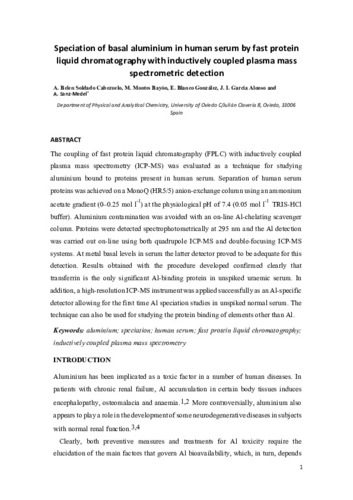Speciation of basal aluminium in human serum by fast protein liquid chromatography with inductively coupled plasma mass spectrometric detection
Palabra(s) clave:
aluminium speciation human serum fast protein liquid chromatography inductively coupled plasma mass spectrometry
Fecha de publicación:
Versión del editor:
Citación:
Descripción física:
Resumen:
The coupling of fast protein liquid chromatography (FPLC) with inductively coupled plasma mass spectrometry (ICP-MS) was evaluated as a technique for studying aluminium bound to proteins present in human serum. Separation of human serum proteins was achieved on a MonoQ (HR5/5) anion-exchange column using an ammonium acetate gradient (0-0.25 mol l(-1)) at the physiological pH of 7.4 (0.05 mol l(-1) TRIS-HCl buffer). Aluminium contamination was avoided with an on-line Al-chelating scavenger column. Proteins were detected spectrophotometrically at 295 nm and the Al detection was carried out on-line using both quadrupole ICP-MS and double-focusing ICP-MS systems. At metal basal levels in serum the latter detector proved to be adequate for this detection. Results obtained with the procedure developed confirmed clearly that transferrin is the only significant Al-binding protein in unspiked uraemic serum. In addition, a high-resolution ICP-MS instrument was applied successfully as an Al-specific detector allowing for the first time Al speciation studies in unspiked normal serum. The technique can also be used for studying the protein binding of elements other than Al
The coupling of fast protein liquid chromatography (FPLC) with inductively coupled plasma mass spectrometry (ICP-MS) was evaluated as a technique for studying aluminium bound to proteins present in human serum. Separation of human serum proteins was achieved on a MonoQ (HR5/5) anion-exchange column using an ammonium acetate gradient (0-0.25 mol l(-1)) at the physiological pH of 7.4 (0.05 mol l(-1) TRIS-HCl buffer). Aluminium contamination was avoided with an on-line Al-chelating scavenger column. Proteins were detected spectrophotometrically at 295 nm and the Al detection was carried out on-line using both quadrupole ICP-MS and double-focusing ICP-MS systems. At metal basal levels in serum the latter detector proved to be adequate for this detection. Results obtained with the procedure developed confirmed clearly that transferrin is the only significant Al-binding protein in unspiked uraemic serum. In addition, a high-resolution ICP-MS instrument was applied successfully as an Al-specific detector allowing for the first time Al speciation studies in unspiked normal serum. The technique can also be used for studying the protein binding of elements other than Al
ISSN:
DOI:
Colecciones
- Artículos [37549]
- Química Física y Analítica [639]
Ficheros en el ítem





